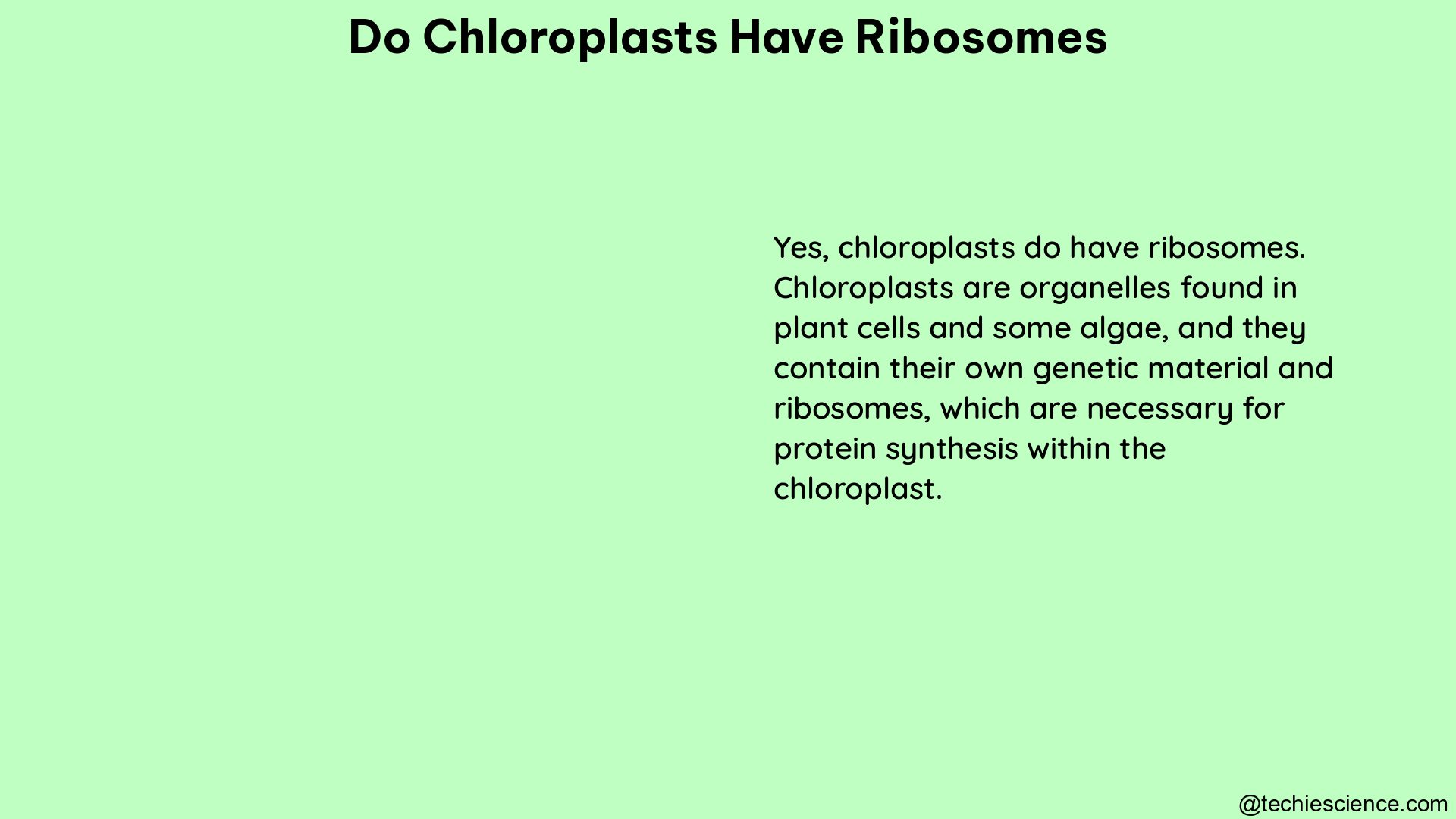Chloroplasts, the organelles responsible for photosynthesis in plant cells, are known to possess their own genetic material and a complex internal structure. One of the key features of chloroplasts is the presence of ribosomes, which are essential for the synthesis of proteins required for their proper functioning. In this comprehensive blog post, we will delve into the details of chloroplast ribosomes, their structure, function, and the evidence supporting their existence.
The Presence of Ribosomes in Chloroplasts
Chloroplasts are semi-autonomous organelles, meaning they possess their own DNA and the machinery necessary for protein synthesis. This includes the presence of ribosomes, which are the cellular structures responsible for the translation of messenger RNA (mRNA) into functional proteins.
The presence of ribosomes in chloroplasts is well-established and supported by various lines of evidence:
-
Structural Analysis: High-resolution structural studies, such as cryo-electron microscopy and X-ray crystallography, have directly visualized the ribosomes within chloroplasts. These studies have revealed that the chloroplast ribosomes are prokaryotic-type 70S ribosomes, composed of a small 30S subunit and a large 50S subunit, similar to those found in bacteria.
-
Genome-wide Analyses: Genome-wide analyses of chloroplast translation have identified the presence of genes encoding ribosomal proteins and other translation-related components within the chloroplast genome. This provides strong evidence for the existence of a functional translation machinery within chloroplasts.
-
Identification of Translation Factors: Researchers have identified specific factors that control protein synthesis in chloroplasts, such as translation initiation factors, elongation factors, and release factors. The presence of these translation-related components further supports the notion that chloroplasts have ribosomes and a functional translation machinery.
Structure and Composition of Chloroplast Ribosomes

The ribosomes found in chloroplasts are structurally and functionally similar to bacterial ribosomes, but with some notable differences:
Subunit Composition
- Small Subunit (30S): The small subunit of the chloroplast ribosome, known as the 30S subunit, is composed of a 16S rRNA molecule and approximately 21 ribosomal proteins.
- Large Subunit (50S): The large subunit of the chloroplast ribosome, known as the 50S subunit, is composed of a 23S rRNA molecule, a 5S rRNA molecule, and approximately 33 ribosomal proteins.
Ribosomal Proteins
- The chloroplast ribosomes contain orthologs of most bacterial ribosomal proteins, indicating a close evolutionary relationship between chloroplasts and prokaryotes.
- However, there are also some unique ribosomal proteins found in chloroplasts, which may have specialized functions or structural adaptations specific to the chloroplast environment.
Structural Deviations
- While the overall structure of chloroplast ribosomes is similar to bacterial ribosomes, there are some structural deviations that may have functional consequences.
- For example, the chloroplast 30S subunit has a unique structure in the region responsible for mRNA binding, which may influence the translation initiation process.
The Role of Chloroplast Ribosomes in Protein Synthesis
The ribosomes in chloroplasts play a crucial role in the synthesis of proteins required for the proper functioning of the organelle. This process, known as chloroplast translation, is essential for cellular viability and plant development.
Chloroplast Translation
- Chloroplast translation is positioned at the intersection of organellar RNA and protein metabolism, making it a unique point for the regulation of gene expression in response to internal and external cues.
- The chloroplast translation machinery is responsible for the synthesis of proteins encoded by the chloroplast genome, which include key components of the photosynthetic apparatus, as well as other essential chloroplast-specific proteins.
Regulation of Chloroplast Translation
- The regulation of chloroplast translation is a complex process that involves various factors, such as translation initiation factors, elongation factors, and release factors.
- These factors help to ensure the efficient and accurate translation of mRNAs into proteins, and they may also play a role in the coordination of chloroplast gene expression with the nuclear genome.
Importance for Cellular Viability and Plant Development
- The proper functioning of the chloroplast translation machinery is crucial for the overall health and viability of the cell, as chloroplasts are essential for photosynthesis and other metabolic processes.
- Disruptions in chloroplast translation can have severe consequences for plant development, as the chloroplast-encoded proteins are essential for the proper structure and function of the organelle.
Conclusion
In summary, chloroplasts do possess ribosomes, which are essential for the synthesis of proteins required for the proper functioning of the organelle. These ribosomes are prokaryotic-type 70S ribosomes, composed of a small 30S subunit and a large 50S subunit, and they contain orthologs of most bacterial ribosomal proteins.
The presence of ribosomes in chloroplasts is well-supported by various lines of evidence, including structural analyses, genome-wide analyses of chloroplast translation, and the identification of specific factors that control protein synthesis in plastids. The chloroplast ribosomes play a crucial role in the regulation of gene expression and the synthesis of proteins essential for cellular viability and plant development.
Understanding the structure and function of chloroplast ribosomes is an important aspect of plant biology, as it provides insights into the evolution and adaptation of these organelles, as well as their integration with the overall cellular metabolism and signaling pathways.
References:
- Tiller, N., & Bock, R. (2014). The translational apparatus of plastids and its role in plant development. Molecular plant, 7(7), 1105-1120.
- Yamaguchi, K., & Subramanian, A. R. (2000). The plastid ribosomal proteins: identification of all the proteins in the 50 S subunit of an organelle ribosome (chloroplast). Journal of Biological Chemistry, 275(37), 28466-28482.
- Schmitz-Linneweber, C., & Small, I. (2008). Pentatricopeptide repeat proteins: a socket set for organelle gene expression. Trends in plant science, 13(12), 663-670.
- Zoschke, R., Liere, K., & Börner, T. (2007). From seedling to mature plant: arabidopsis plastidial genome copy number, RNA accumulation and transcription are differentially regulated during leaf development. The Plant Journal, 50(4), 710-722.
- Manuell, A. L., Quispe, J., & Mayfield, S. P. (2007). Structure of the chloroplast ribosome: novel domains for translation regulation. PLoS biology, 5(8), e209.

I am a doctoral student of CSIR- CIMAP, Lucknow. I am devoted to the field of plant metabolomics and environmental science. I have completed my post-graduation from the University of Calcutta with expertise in Molecular Plant Biology and Nanotechnology. I am an ardent reader and incessantly developing concepts in every niche of biological sciences. I have published research articles in peer-reviewed journals of Elsevier and Springer. Apart from academic interests, I am also passionate about creative things such as photography and learning new languages.
Let’s connect over Linkedin